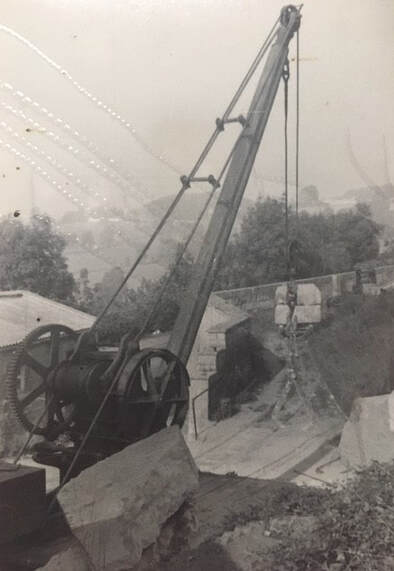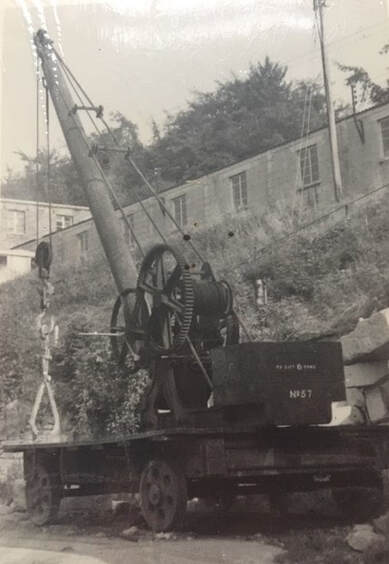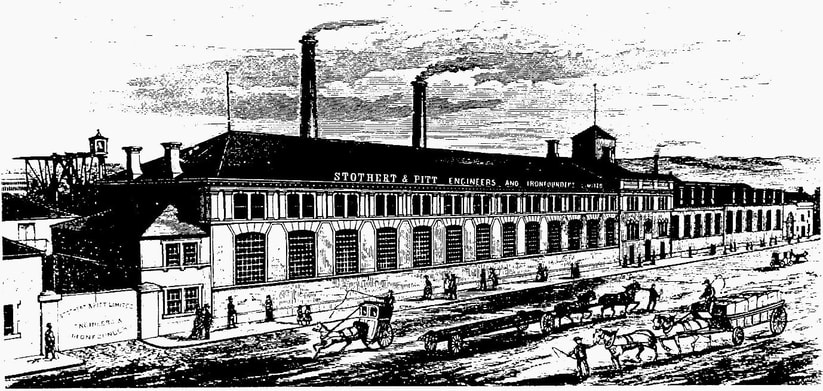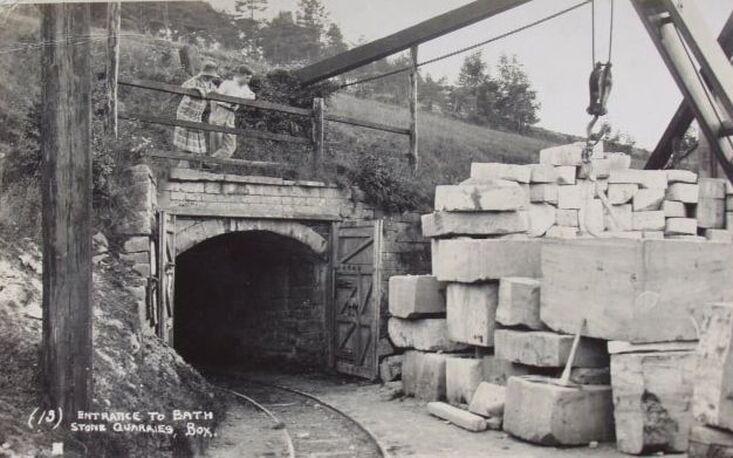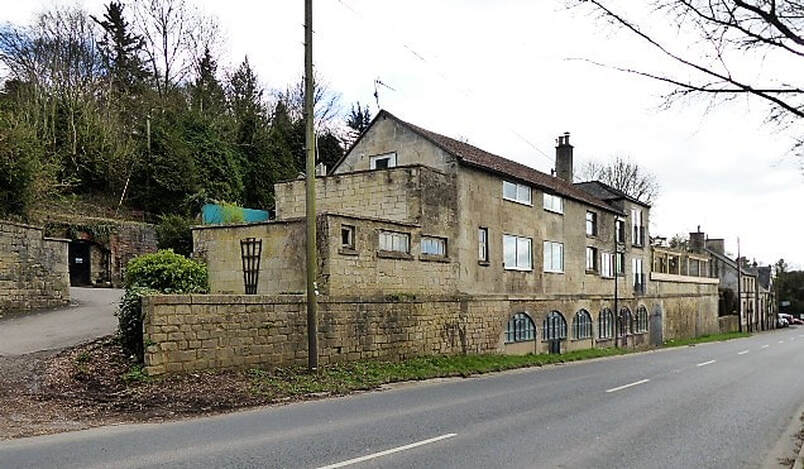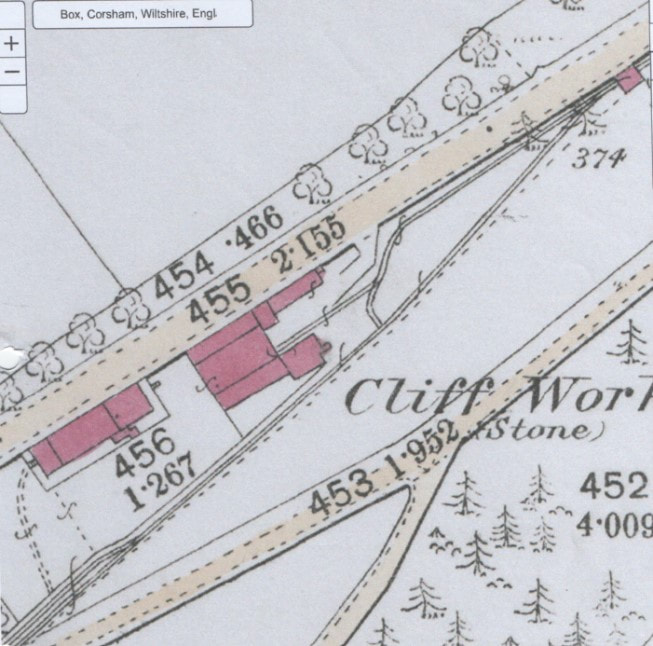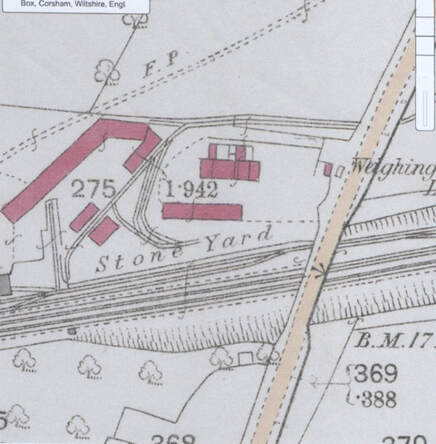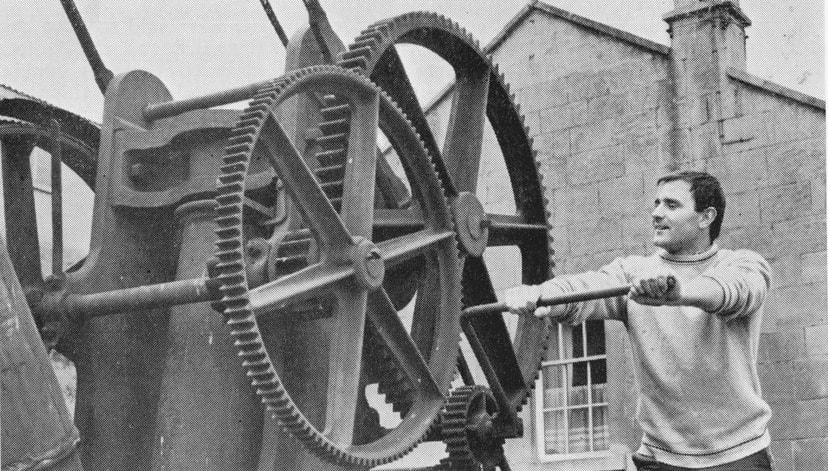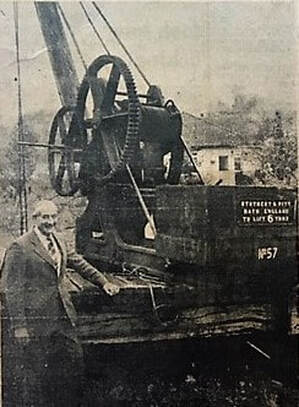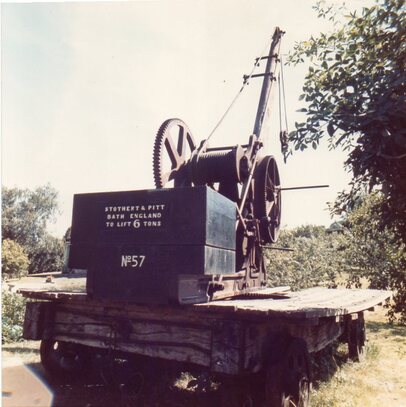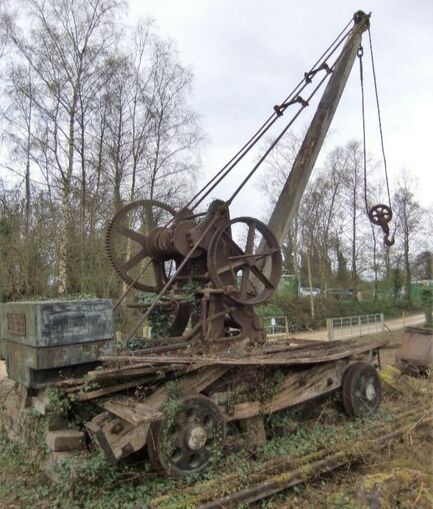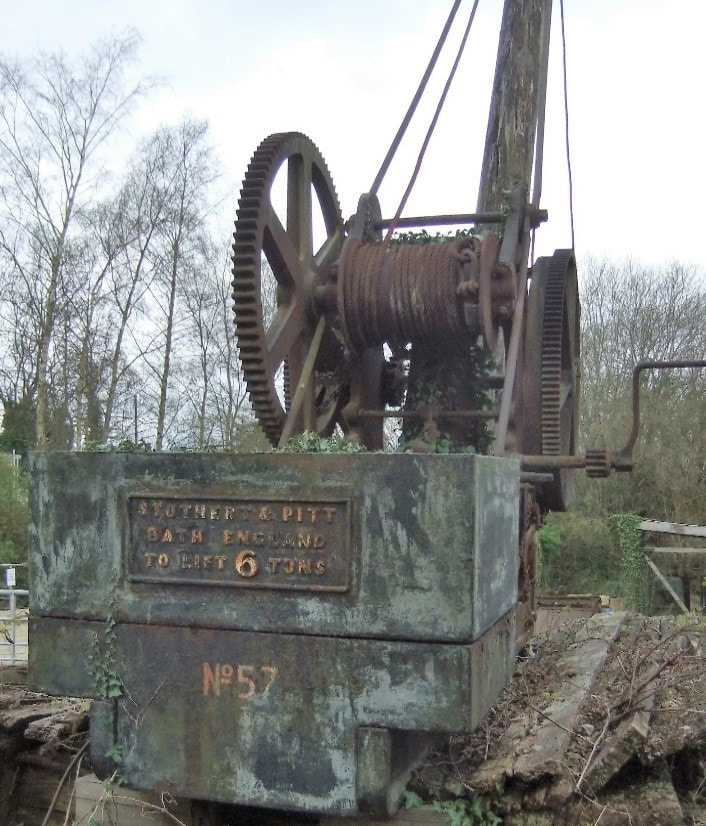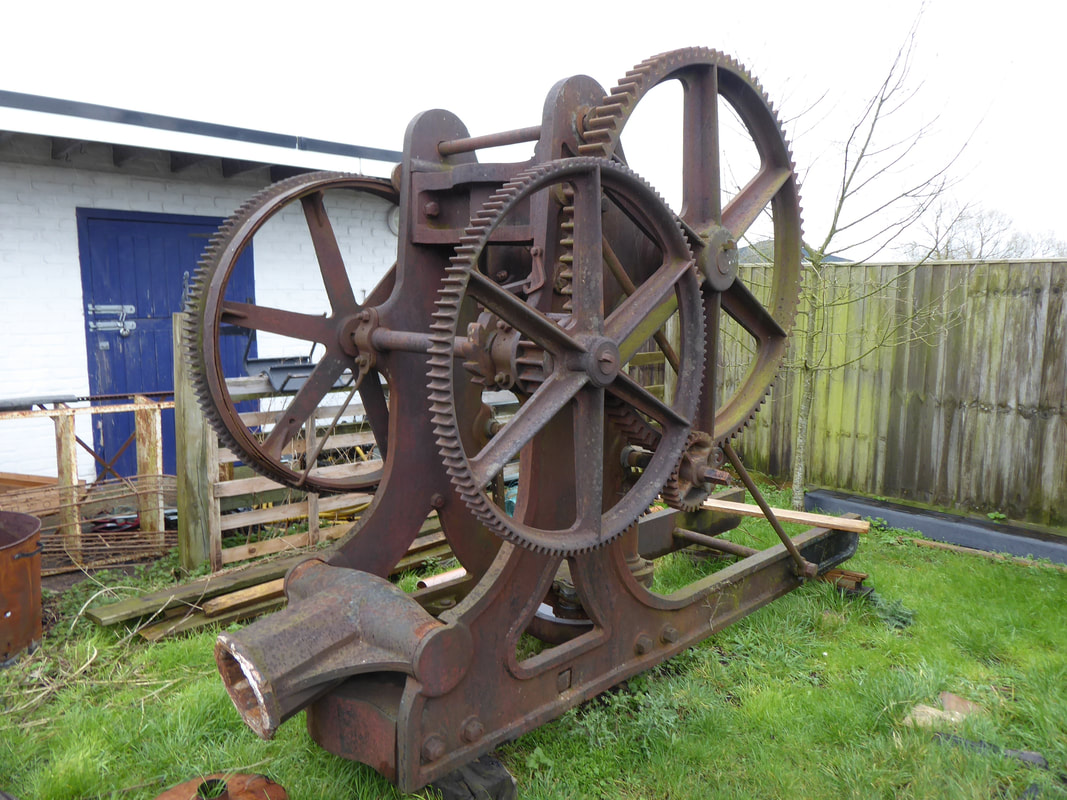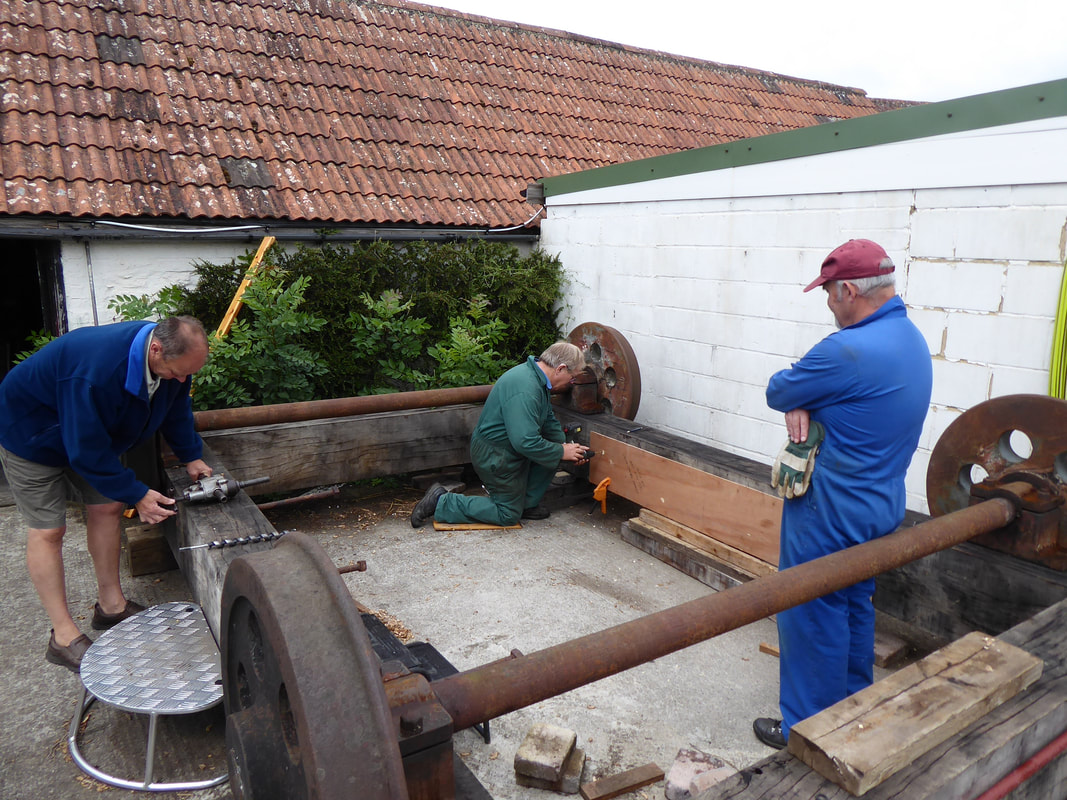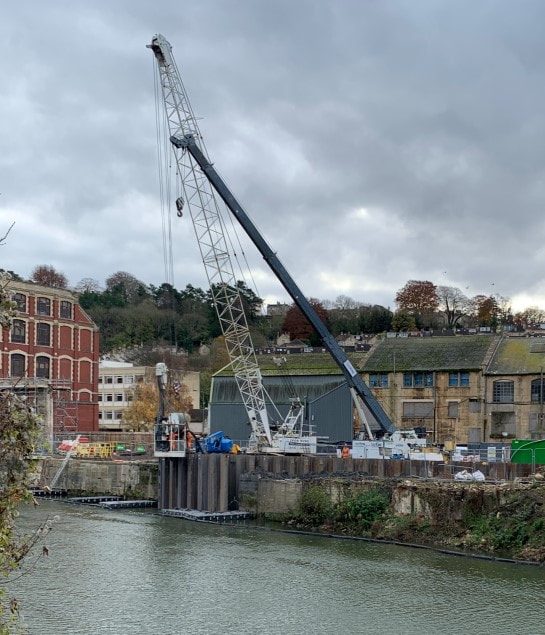Box’s Historic Crane number 57 Varian Tye October 2020
The crane at Clift Quarry on Box Hill (courtesy Nina Pollard) At this time it is understood that the tramway from the stone yard at the GWR had ceased and stone blocks were being loaded onto a lorry in the yard for distribution
This unique Stothert and Pitt 6-ton crane is being restored. It is a magnificent visual reminder of the historic engineering firm of Stothert and Pitt and the quarrying history of the parish of Box.
Stothert and Pitt: Crane Makers to the World
Historic England called the engineering company Stothert and Pitt the most famous crane makers in the world.[1] The company was based at the Newark Works, Lower Bristol Road, Bath from the late 1850s until 1989. The architectural and historic significance of the buildings, which still survive facing Lower Bristol Road, have been recognised by their Grade II listing.[2] At the Great Exhibition of 1851 the firm exhibited an early hand crane and although they produced a number of products through the rest of the century their crane manufacturing became dominant. They built some enormous structures: huge dockside products and a swivel bridge at Frome.
Unlike many other cranes built by Stothert and Pitt, the Box crane was a small piece of equipment, mobile and more easily manoeuvrable, and used for lighter lifts. This was especially so compared to some of Stothert and Pitt’s enormous products, such as the 35-ton steam crane on the quayside outside the M-Shed, Bristol (now a scheduled ancient monument), or the 70-ton crane for Natal harbour and breakwater.[3]
In addition to the association with Box as the manufacture and supplier of the Box Crane, the Stotherts had earlier links. They probably supplied water pumps from Bath which helped pump water out of the Box Tunnel when under construction and lifting equipment may have also been supplied. A Mr Stothert was one of the contractors who started construction of Box Tunnel from the Corsham end.
Historic England called the engineering company Stothert and Pitt the most famous crane makers in the world.[1] The company was based at the Newark Works, Lower Bristol Road, Bath from the late 1850s until 1989. The architectural and historic significance of the buildings, which still survive facing Lower Bristol Road, have been recognised by their Grade II listing.[2] At the Great Exhibition of 1851 the firm exhibited an early hand crane and although they produced a number of products through the rest of the century their crane manufacturing became dominant. They built some enormous structures: huge dockside products and a swivel bridge at Frome.
Unlike many other cranes built by Stothert and Pitt, the Box crane was a small piece of equipment, mobile and more easily manoeuvrable, and used for lighter lifts. This was especially so compared to some of Stothert and Pitt’s enormous products, such as the 35-ton steam crane on the quayside outside the M-Shed, Bristol (now a scheduled ancient monument), or the 70-ton crane for Natal harbour and breakwater.[3]
In addition to the association with Box as the manufacture and supplier of the Box Crane, the Stotherts had earlier links. They probably supplied water pumps from Bath which helped pump water out of the Box Tunnel when under construction and lifting equipment may have also been supplied. A Mr Stothert was one of the contractors who started construction of Box Tunnel from the Corsham end.
Box’s Quarry Crane number 57
The Box crane is special - believed to be the oldest surviving crane of its type manufactured by Stothert and Pitt and manufactured in or close to 1864. The number 57 may be a quarry reference number.
During its quarrying life, the crane was used to lift block stone from quarry trolleys onto the main railway wagons at Pictor’s Wharf at the foot of Box Hill (now the site of the Brunel Nursing Home) for transportation on the Great Western Railway Line.[4] The quarry trolleys ran on a tramway from the wharf up to Clift Quarry on Box Hill which was opened in 1865 by Pictor and Sons. Around the time of World War II, the crane was bought by Hibbards Saw Mill, Biddestone, but never used by them. In the 1960s the Bath and Portland Stone Firms brought it back to Clift Quarry on the A4 road at Box Hill until the quarry closed in 1968.
The Box crane is special - believed to be the oldest surviving crane of its type manufactured by Stothert and Pitt and manufactured in or close to 1864. The number 57 may be a quarry reference number.
During its quarrying life, the crane was used to lift block stone from quarry trolleys onto the main railway wagons at Pictor’s Wharf at the foot of Box Hill (now the site of the Brunel Nursing Home) for transportation on the Great Western Railway Line.[4] The quarry trolleys ran on a tramway from the wharf up to Clift Quarry on Box Hill which was opened in 1865 by Pictor and Sons. Around the time of World War II, the crane was bought by Hibbards Saw Mill, Biddestone, but never used by them. In the 1960s the Bath and Portland Stone Firms brought it back to Clift Quarry on the A4 road at Box Hill until the quarry closed in 1968.
The surviving quarry buildings at Clift Quarry are located near the entrance into the underground quarry. The above complex of historic buildings, although altered, may still be regarded as heritage assets worthy of conservation as is the historic underground quarry.
These extracts from the 1844 -1888 Ordnance Survey map (courtesy the Know Your Place website) show left Clift Quarry Works buildings and tramway (above left) and Pictor’s Wharf and stone yard with tramway (above right). From the Quarry, the tramway continued under the main road then down to the Wharf and stone yard.
When it was due to be scrapped in 1971, the crane was acquired by Box’s doctor, Dr Jim Davey, for £50. He recalled: I’d seen the crane working many, many times when I visited patients who lived by the entrance of the quarry and I thought it would be a shame if it was scrapped.[5] He stored in his garden at Ashley Croft, Box, where it became one of the family, admired by visitors and a talking point for local villagers.[6]
A decade later in the mid-1980s, Jim and June Davey wanted to find a new home for the crane. David Pollard stepped in to save the crane, but first he offered it to Iron Bridge who turned it down. He then arranged for a group of volunteers to help move the crane from Ashley in 1983, which necessitated a 9 ft gauge track, 30 ft long, which was supplied by Pickfords, Bath, to a site that he had just bought, known today as Hartham Park Quarry, Corsham. It also needed specialist lifting equipment from Sparrows Crane Hire and a low loader from Brooks Transport, Bristol. From this beginning David started a collection of quarrymen's tools and set up the Bath Stone Quarry Museum Trust.
A decade later in the mid-1980s, Jim and June Davey wanted to find a new home for the crane. David Pollard stepped in to save the crane, but first he offered it to Iron Bridge who turned it down. He then arranged for a group of volunteers to help move the crane from Ashley in 1983, which necessitated a 9 ft gauge track, 30 ft long, which was supplied by Pickfords, Bath, to a site that he had just bought, known today as Hartham Park Quarry, Corsham. It also needed specialist lifting equipment from Sparrows Crane Hire and a low loader from Brooks Transport, Bristol. From this beginning David started a collection of quarrymen's tools and set up the Bath Stone Quarry Museum Trust.
Dr Jim Davey with the crane in 1984 (courtesy Chippenham Times and News, 4 November 1983)
Restoration
Until recently the crane was stored at Hartham Park Stone Quarry, Corsham. The Bath Stone Quarry Museum Trust were concerned with the safety of the structure due to its poor condition.
Until recently the crane was stored at Hartham Park Stone Quarry, Corsham. The Bath Stone Quarry Museum Trust were concerned with the safety of the structure due to its poor condition.
The crane at Hartham Park Quarry before careful dismantling for restoration (courtesy Varian Tye)
David’s widow along with a small team of Industrial history enthusiasts, who were aware of the crane’s importance, prepared a plan to conserve and repair the crane, as it was in danger of collapsing. The Bath Stone Quarry Museum Trust was prepared to donate it, if a suitable site could be found for its public display, hopefully in the city of Bath on the former site of Stothert and Pitt's Newark Works. The team included Peter Dunn (ex-Stothert and Pitt apprentice, commissioning and service engineer) who surveyed the crane in 2017. The principle of minimum intervention to historic fabric was adopted in conservation and repair, balanced with the need to make the crane safe and display it in the open to the public.
The Box crane undergoing restoration (courtesy Varian Tye)
Drawings and photographic records have been kept of the work and will continue to be taken. When recording is complete, it is intended that the records will be submitted to the Historic Environment Records for Bath and North East Somerset, now held by south-west Heritage Trust at Taunton.
Funding to enable the extensive works has had to be raised. Funds have been obtained from The Bath Stone Quarry Museum Trust, Bristol Industrial Archaeological Society and more recently £4,000 was received as a grant from The Association of Industrial Archaeology, a nationwide association that supports the study, preservation and presentation of industrial heritage in Britain since 1973.[7]
Final Word
The restoration of such an important piece of Box’s history is a magnificent achievement and a tribute to those who recognised its importance from the outset, including Dr Jim Davey and David Pollard. A special thanks should also go to those parties who have helped so far in funding the works undertaken and those involved with the project including the small team restoring the crane. Local written support for the restoration of the Box Crane has been given by Box Parish Council and Wiltshire Councillors covering the parish of Box, Dr Brian Matthews and Ben Anderson.
Stuart Burroughs, Director of the Museum of Bath at Work, summed up the crane's significance: The return of this crane, to its home town and to the site where it was manufactured, is important enough, but the display and interpretation of this item helps correct the perception of Bath as a city of Georgian elegance, by showing a product of its working life. Stothert and Pitt spread their cranes to many ports throughout the world; this crane brings home that manufacturing heritage.
Funding to enable the extensive works has had to be raised. Funds have been obtained from The Bath Stone Quarry Museum Trust, Bristol Industrial Archaeological Society and more recently £4,000 was received as a grant from The Association of Industrial Archaeology, a nationwide association that supports the study, preservation and presentation of industrial heritage in Britain since 1973.[7]
Final Word
The restoration of such an important piece of Box’s history is a magnificent achievement and a tribute to those who recognised its importance from the outset, including Dr Jim Davey and David Pollard. A special thanks should also go to those parties who have helped so far in funding the works undertaken and those involved with the project including the small team restoring the crane. Local written support for the restoration of the Box Crane has been given by Box Parish Council and Wiltshire Councillors covering the parish of Box, Dr Brian Matthews and Ben Anderson.
Stuart Burroughs, Director of the Museum of Bath at Work, summed up the crane's significance: The return of this crane, to its home town and to the site where it was manufactured, is important enough, but the display and interpretation of this item helps correct the perception of Bath as a city of Georgian elegance, by showing a product of its working life. Stothert and Pitt spread their cranes to many ports throughout the world; this crane brings home that manufacturing heritage.
The current development site at the historic Stothert and Pitt Newark Works, Bath, with the protected listed buildings in the background. It is proposed the restored crane be located on this site. The council proposes to link the site to the other side of the river by a new pedestrian bridge (photo courtesy www.bathnewseum.com).
References
[1] Ken Andrews and Stuart Burrows wrote in 2003: Stothert and Pitt Cranemakers to the World and noted that in 1980 the then Director of the Science Museum claimed the contribution by Stothert and Pitt as a supplier of heavy engineering across the world was Bath’s greatest contribution to world history.
[2] https://historicengland.org.uk/listing/the-list/list-entry/1395130
[3] www.gracesguide.co.uk/Stothert,_Rayno_and_Pitt
[4] Courtesy David Pollard
[5] Bath and West Evening Chronicle, 13 February 1984
[6] Chippenham Times and News, 4 November 1983
[7] See https://industrial-archaeology.org
[1] Ken Andrews and Stuart Burrows wrote in 2003: Stothert and Pitt Cranemakers to the World and noted that in 1980 the then Director of the Science Museum claimed the contribution by Stothert and Pitt as a supplier of heavy engineering across the world was Bath’s greatest contribution to world history.
[2] https://historicengland.org.uk/listing/the-list/list-entry/1395130
[3] www.gracesguide.co.uk/Stothert,_Rayno_and_Pitt
[4] Courtesy David Pollard
[5] Bath and West Evening Chronicle, 13 February 1984
[6] Chippenham Times and News, 4 November 1983
[7] See https://industrial-archaeology.org
